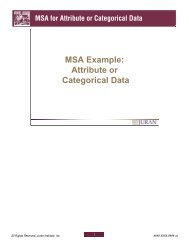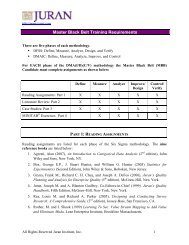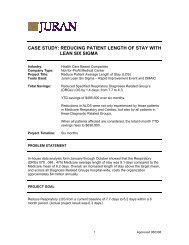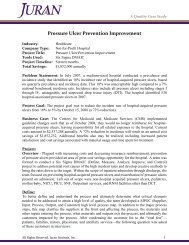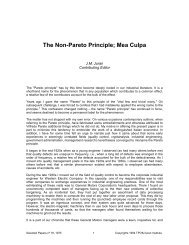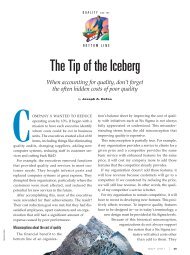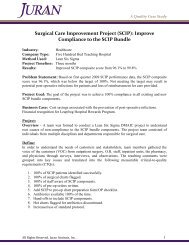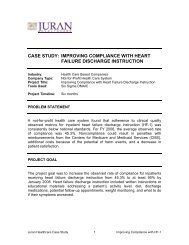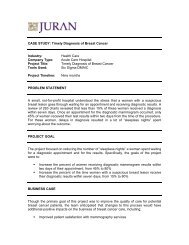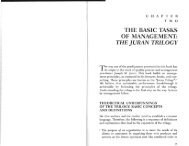Genentech Error Proofs Its Batch Records.pdf - Juran Institute
Genentech Error Proofs Its Batch Records.pdf - Juran Institute
Genentech Error Proofs Its Batch Records.pdf - Juran Institute
You also want an ePaper? Increase the reach of your titles
YUMPU automatically turns print PDFs into web optimized ePapers that Google loves.
DOCUMENTATIONwithin customer defined timelines.Data from the first and second quarters of 2003were analyzed by the team to identify master ticketerrors and map them to process steps when theerror could have originated or been caught (individualerrors were often mapped to multiple locations).This analysis identified the document developmentstage of the process—including technical writingand subject matter expert redline steps—as the mostsignificant generator of ticket errors (see Figure 7).A VSM of the process was created and used toshow only four of the 54 steps were value adding,two were nonvalue adding and the remaining 48were all classified as “needed but nonvalueadding.”A failure mode effects analysis of the processranked the various identified failure modes, androot causes were assigned to the most severe ones.The top 10 risk priority number scores could beassigned to three root causes: communicationgaps, business process inadequacies and resourcelimitations.The team designed an improved process usingDMADV methodology to address the identifiedissues and converted three root causes to customerneeds. The improved process—which features acentralized coordinator, automated step references,resource management tools and developmentchecklists—was piloted in the fall of 2004.Compared to the baseline data, the campaignpreparation effort delivered accurate documentsin accordance with defined timelines.Less complex documents. The problem statementdevised by the document complexity team (aDMADV project) emphasized the link betweendocument errors and instructions to manufacturingand quality assurance staff that were often overlycomplicated or inconsistent.The team interviewed customers (documentusers) across functions and prioritized their identifiedneeds. A Pareto chart of these findings is providedin Figure 8. The three needs identified mostoften were fewer pieces of paper, no conflictinginstructions and fewer data entries.FIGURE 7Pareto Chart of Performance Gaps140120100806040200SubjectmatterexpertredlinecreationTechwritingParalleldocumentapprovalDocumentownerreviewWordprocessingTecheditorreviewTecheditingQuality Sequentialassurance approvalchangemanagement<strong>Error</strong>s, n = 482SumFirst and second quarter 2003 data show combined origin and “miss” steps where error could have been caught.32 IJULY 2005 Iwww.asq.org



